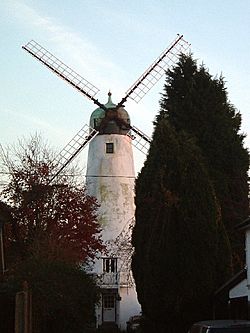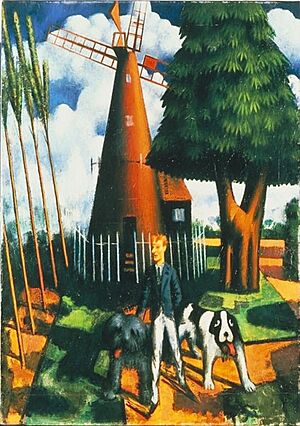Hawridge Windmill facts for kids
Quick facts for kids Hawridge Mill |
|
|---|---|

Hawridge Mill
|
|
| Origin | |
| Mill name | Hawridge Mill |
| Mill location | SP 934 068 |
| Coordinates | 51°45′12″N 0°38′51″W / 51.75333°N 0.64750°W |
| Year built | 1883 |
| Information | |
| Purpose | Corn mill |
| Type | Tower mill |
| Storeys | Four storeys |
| No. of sails | Four sails |
| Type of sails | single sails |
| Winding | Fantail |
| Fantail blades | six blades |
| Auxiliary power | Originally a steam engine |
| No. of pairs of millstones | Two pairs driven by wind |
Hawridge Windmill, also known as Cholesbury Windmill, is an old tower mill located in Hawridge, Buckinghamshire. It was built where an older smock mill once stood. In 1913, the mill became a private home. The writer Gilbert Cannan was the first person to live there, using it as his studio.
Contents
History of Hawridge Windmill
A windmill has been on or near this spot since the 1600s or 1700s. Maps from that time show it. The first mill here was a smock mill built in 1863. It was called the Hawridge Wind and Steam Mill. The Norwich Wind and Steam Company built it. They also put in a steam engine and a tall chimney.
This smock mill was sold at least twice. In 1881, it was sold for £600 along with other buildings. However, it seems the mill did not make much money. This was because of its design, building problems, and the high cost of coal. So, the smock mill was taken down in 1883.
A new tower mill was built on the same site in 1883. This was one of the last tower mills ever built in England. Hillsdon's of Tring built it for £300. The tall chimney from the old steam mill was removed the next year. A place to store grain was added soon after.
The first owners of the new mill found it hard to make money. It was sold and then rented out. The mill only became successful when a more experienced miller took over. This miller stayed in charge until the mill stopped working in 1912. It then became a private home in 1913.
About the Mill Buildings
You can reach the mill by its own dirt path. This path crosses Rays Hill Common. The mill is a Grade II listed building. This means it is a special historic building, registered in 1958.
The Smock Mill Design
The first mill, the smock mill, had a two-story brick base. This base was square. On top of it was a narrow, eight-sided wooden tower. This tower was covered in tar. It had four double-shuttered sails. A six-bladed fantail helped the mill turn to face the wind. All the working parts were inside a turning cap at the top.
The Tower Mill Design
The tower mill has four floors. It is made of brick and covered in black plaster. After it stopped working, it was painted white and black at different times. Today, it is painted white. The image from 1998 shows it in white.
The sails were kept even after the mill became a home. But they wore out over the years. In the 1950s, a strong wind blew one sail off. In 1968, the person living there fixed it up. They replaced the old sails with fake ones and painted them red and white. Inside the cap, which is the original one, you can still see the rollers, gears, and the main shaft that held the sails.
The Millers Who Worked Here
The first miller of the smock mill was Thomas Moreton. He was from Nuneaton. Charles Pedel, a helper from Wendover, worked with him. By 1871, Joseph Salt from Congleton had taken over. In 1877, George Wright from Cholesbury was the miller. In 1881, Harry Wright from Tring, Hertfordshire, was the last miller of this first mill.
Daniel Dwight was the first miller of the newly built tower mill. The mill changed owners, and Thomas Robinson took over in 1891. He was from Moulton, Northamptonshire and knew a lot about steam-powered mills. He continued to be the miller until the mill closed in 1912. After that, he retired and lived at the nearby manor house.
Public Access to the Mill
The mill has been changed into a private home. Because of this, it is not open for the public to visit.
Hawridge Mill in Culture
After the mill stopped working in 1912, it was changed into a home. This happened to the mill tower and the mill house. In the spring of 1913, writer Gilbert Cannan and his new wife Mary moved in. Mary had been married to J. M. Barrie, who created Peter Pan.
The Cannans quickly decorated their new home in a modern style. They turned the mill tower into a studio. They also bought land behind the house to make a garden. They invited many friends to stay. Many of these friends were artists from groups like the Bloomsbury Group and the London Group. These groups were important around the time of the First World War. The Cannans often had so many friends visiting that they had to rent nearby cottages.
D. H. Lawrence and his wife Freda rented a cottage nearby. Katherine Mansfield and John Middleton Murry stayed next door to the Cannans. Later, they rented a cottage three miles away. In December 1914, the group was joined by writer S. S. Koteliansky and painter Mark Gertler. They all had a fun Christmas, partying at each other's houses. These events at Cholesbury were shown in paintings. They also became stories in letters, memories, and books later on.
Mark Gertler stayed at a nearby house from 1915 to 1916. He soon set up his studio in the mill tower. He painted a famous picture of the mill called Gilbert Cannan at his Mill. This painting is now in the Ashmolean Museum in Oxford. The picture shows Cannan outside the mill with his two dogs. One of the dogs, which is black and white, is thought to be a dog that used to belong to the Barries.
The original dog that inspired Nana in Peter Pan was Porthos. Porthos was a St Bernard belonging to the Barries. When Porthos died, the Barries got a new dog named Luath. Luath was a black and white Newfoundland dog. The actor who played Nana in the first Peter Pan play studied Luath's behavior. The costume worn in this play was also black and white.
People who visited the mill sometimes called it 'a poor man's Garsington'. This was because Garsington Manor near Oxford was a famous artists' retreat. Lady Ottoline Morrell, who owned Garsington, often visited the mill too. Writer Compton Mackenzie was a regular visitor. He based characters in his big book, The Four Winds of Love, on the Cannans and Lawrences. His memories of staying at the mill appear in his book.
Other friends of the Cannans included writer David Garnett, philosopher Bertrand Russell, and historian G. M. Trevelyan. Like Cannan, Eddie Marsh supported new artists. He visited with novelists Maurice Hewlett and Hugh Walpole. Gertler invited painter Dora Carrington to the mill. He liked her very much, but she ended up with writer Lytton Strachey, who also stayed at the mill sometimes. Gilbert Cannan was a long-time friend of poet John Drinkwater. Drinkwater's poem September mentions Cholesbury.
The Cannans left the mill in 1916. In 1917, their friend Doris Keane rented it. She was a famous American actress. She used the mill as a weekend getaway while performing in London. In the 1930s, artist Bernard Adams used the mill as an art studio and for classes. During the Second World War, the Home Guard used it as a lookout post. Later in the 1900s, Sir David Hatch owned it. He was a BBC radio producer and director.
Images for kids




